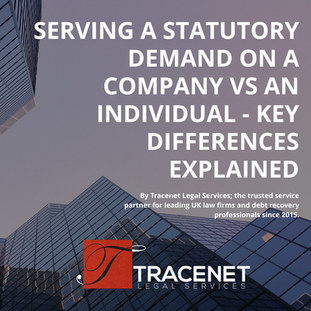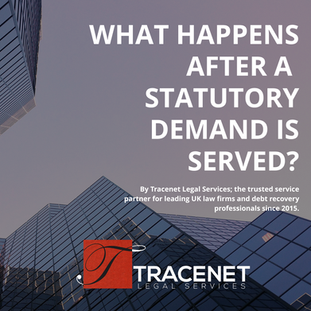

SERVING A STATUTORY DEMAND ON A COMPANY VS AN INDIVIDUAL - KEY DIFFERENCES EXPLAINED
1️⃣ Introduction A statutory demand is one of the most powerful debt recovery tools in UK insolvency law. But its strength depends...


HOW TO PROVE SERVICE OF A STATUTORY DEMAND - CERTIFICATES, STATEMENTS & SWORN EVIDENCE
A complete UK guide for creditors and solicitors: how to prove service of a statutory demand using Certificates of Service, Statements of Attempts, and Sworn Affidavits. By Tracenet Legal Services.


WHAT HAPPENS AFTER A STATUTORY DEMAND IS SERVED?
Serving a statutory demand is one of the most effective tools for creditors to enforce payment of clear, undisputed debts. However, once served, a precise legal clock begins ticking — and any failure to act properly can weaken a creditor’s position and waste time and money.
Creditors, solicitors and debt recovery professionals must understand exactly what happens next, how debtors can respond, and how to escalate correctly to bankruptcy or winding-up proceedings if the debtor


HOW LONG DOES A DEBTOR HAVE TO RESPOND TO A STATUTORY DEMAND?
Statutory demands remain one of the most direct and cost-effective pre-insolvency tools available to creditors in the UK. In this guide, Tracenet Legal Services explains exactly how long a debtor has to respond to a Statutory Demand, the consequences of missing the statutory deadline, and practical steps creditors should take to protect their recovery rights and avoid costly procedural pitfalls.


CAN A DEBTOR SET ASIDE A STATUTORY DEMAND?
A statutory demand is a powerful tool for creditors: it signals that a debt is serious, undisputed, and must be settled within a strict time frame or insolvency proceedings may follow. However, debtors are not without defences. UK insolvency law provides a mechanism for a debtor to set aside a statutory demand if they can show that the demand is defective, the debt is genuinely disputed, or other grounds apply.


WHAT HAPPENS IF, ONCE SERVED, A STATUTORY DEMAND IS IGNORED
Serving a statutory demand is a serious step for creditors — and ignoring one is a risky mistake for debtors. Statutory demands are not idle threats; they are formal legal notices under the Insolvency Act 1986 that can quickly lead to bankruptcy or a winding-up petition if left unanswered.
This article explains exactly what happens if a debtor ignores a statutory demand and why using a professional process server like Tracenet Legal Services protects your right to enforce


COMMON MISTAKES WHEN SERVING A STATUTORY DEMAND
Serving a statutory demand is one of the most effective tools for creditors to recover an undisputed debt. It places the debtor under serious legal pressure: pay up within 21 days or risk bankruptcy or a winding-up petition. However, statutory demands come with strict procedural rules. Even minor mistakes can give a debtor grounds to challenge the demand, costing you time and money


THE LEGAL BASIS FOR SERVING STATUTORY DEMANDS IN THE UK
Introduction In the realm of debt recovery, a statutory demand is one of the most potent tools available to creditors — but it only works...


STATUTORY DEMAND SERVICE
IS YOUR CURRENT PROCESS SERVER A TRUE STATUTORY DEMAND EXPERT? Serving a statutory demand is a critical legal step, not just a simple delivery job. The risks of using a generalist are too high: failed attempts, incorrect service, and weak reporting that can lead to costly delays or a demand being set aside.

